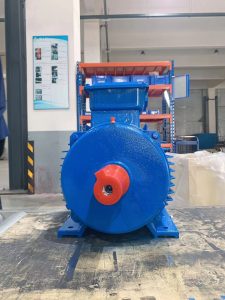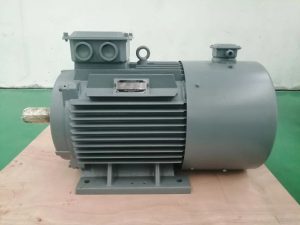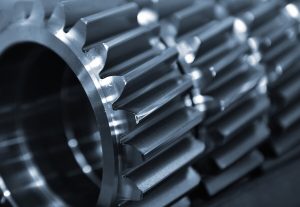PM Motors have, nowadays, joined the Industrial sector, too. Unlike in Induction Motors, in PM motors, the rotor has attached magnets that create the field when the operation is started. This paper gives insight into the concepts, principles, and key components involving PM motors.

The most fundamental difference, between PM motors and induction motors, concerns the method of magnetic field creation. Induction motors utilize a rotating field induced in the stator windings to induce currents within the rotor, which then interact with the stator field to create da driving force. One of the peculiar features of induction motors is that a velocity difference must be present between the rotor and the magnetic field to induce the current. Because of this fact, they work well when coupled with variable frequency drives to achieve a change in speed.
Magnet motors also termed PM motors, build fields with the help of magnets in the rotor and thus require no stator field to link flux. This naturally adapted design lends itself to higher efficiency in applications requiring speed variation. Based on the magnet placement, there are two primary forms of permanent magnet motors: Surface Permanent Magnet Motors and Interior Permanent Magnet Motors. The durability, magnetic power, and electromagnetic characteristics of the motors vary with type.
To understand the operation of the PM motors, a few of the important related concepts with flux, flux linkage, and magnetic fields have to be understood.
A field is created when a current passes through a conductor. Flux is a measure of the rate of transfer of a characteristic across an area. For motors, flux is how fast the magnetic field is spread out across the surface area of the wires.
Flux linkage is an interaction of a magnetic field with a material, like passing through a coil. It depends on the number of turns in the winding and the magnetic flux, which is often represented by the symbol ϕ that shows the value of the flux with time. The formula for finding the flux linkage is λ = N × ϕ, where λ is the flux linkage, N is the number of turns, and ϕ is the flux.
Magnetic field diagram showing how magnetism is moving around a conductor’s space. In magnet motors, magnets are placed attached to the surface of the rotor to create the field.

When discussing the characteristics of PM motors, it is important to take into consideration the concepts of inductance and EMF.
Inductance, L: It is the proportionality constant of the induced voltage concerning changes in current. In other words, inductance is flux linkage per unit current. It is related to geometric properties: the path of the current, and it is measured in Henry’s (H). Inductance in PM motors can be differentiated into d-axis inductance and q-axis inductance according to the position of the rotor and the magnetic poles.
Back EMF: The voltage is induced within the stator windings because of the relative motion between the magnetic field of the rotor and stator windings during the rotation of the motor. In the case of PM motors, the magnetic field is from permanent magnets on the rotor; hence, voltages will be induced in the stator windings for as long as the rotor is in motion. This causes a back EMF that linearly rises with the increase in speed of the motor, thus becoming a key factor in determining the motor’s maximum operating speed.
There are two important axes employed for the description of the electromagnetic characteristics of PM motors.
D-axis (Direct Axis): It lies along the main flux direction of the motor. D-axis inductance will correspond to the inductance value when the flux flows through the magnetic pole.
Q-axis (Quadrature Axis): It corresponds to the main torque generation direction of the motor. Q-axis inductance will correspond to the inductance value when the flux flows between the magnetic poles.
For interior magnet PM motors, the d-axis and q-axis inductance values are different because the presence of magnets reduces the core material along the d-axis, hence reducing the inductance. For surface PM motors, the d-axis and q-axis inductance values are almost identical since the magnets are on the exterior of the rotor and do not impact the connection of the stator magnetic field to the core.
Magnetic saliency is a measure of the relative variation of the d-axis and q-axis inductance concerning rotor position. One of the most important design considerations for PM motors is magnetic saliency. In most cases, it is maximum at an electrical angle of 90 degrees where the difference between q-axis and d-axis inductance is greatest.
The two major components of the torque developed within the PM motors are magnetic torque and reluctance torque. The magnetic torque is due to the interaction between the rotor magnetic flux and the current of the stator winding. The reluctance torque has its origin in the preference of the rotor axis to get aligned along the stator flux field. The actual output torque of the motor will be decided by both.
The most basic differences in PM motors lie in the fact that with increased load current, the values of d- and q-axis inductance are reduced because of magnetic saturation in the core material. Beyond a certain magnitude of flux, the inductance of the core doesn’t increase further and also may be reduced.
Weakening the flux is a technique that lessens the flux field to decrease the back EMF to allow higher speeds. Typically, this operation needs extra current in the motor, and by changing the direction of the current in the d-axis, the motor can weaken or strengthen the flux by operational demands.
PM motors can be divided into structural types: interior magnet motors and surface magnet motors. Each structural type of PM motor has relative advantages and disadvantages, the choice often relating to the application. For example, in such applications where high mechanical strength at high speeds is in demand, the ideal will be the design with the magnets embedded inside the rotor, while surface magnet motors are easier to make out and result in lower costs.
The performance of PM motors largely depends on the magnetic materials. Permanent magnetic materials generally used in PM motors such as neodymium iron boron (NdFeB) and samarium cobalt (SmCo) are different in characteristics: magnetic performance and high-temperature resistance vary. In this regard, the selection of magnetic material is deeply related to the application scenario, and hence it should be appropriately chosen during the motor design process.
With the advanced development in the field of drive technologies, modern variable-speed AC drives are also capable of self-sensing and even closed-loop control by detecting or tracking the motor’s pole position to maximize the output torque and optimize efficiency. This control scheme finds many applications in servo motors applied in position-control applications, which require both high accuracy and quick speed responses.
Servo motors often have an interior permanent magnet design and are mated with a specific amplifier. The two together, optimized and tuned by the manufacturer, are designed to operate optimally. In practical applications, the servo motors have often seen their implementations in CNC machines, robotics, and automation equipment.
Although these materials are called “permanent magnets,” the name is not permanent in the real sense. Under changes in external conditions, for example, mechanical stress, high temperature, or strong electromagnetic interference, their magnetism may weaken or fail.
Mechanical Stress: Permanent magnets may lose their magnetism due to internal structural changes when subjected to severe impact or dropping.
The influence of temperature on materials is that each one has a temperature, the so-called “Curie temperature,” where it is no longer magnetic.
The magnetic properties of magnets may be interfered with and could result in the loss of magnetism.
It is, therefore essential to consider these demagnetization aspects and incorporate strategies when developing and utilizing PM motors.
X.Enneng: Advancing the Development of high-Efficiency Permanent Magnet Motors
ENNENG was a manufacturer of magnet motors, a company officially known as Qingdao Enneng Magnet Motor Co., Ltd. It is located in the Qingdao region of China. The types of manufacture include standard, common, and customized types like gearless and driven. Motors made at ENPMSM cater to industries in the power plants, metallurgies, chemical fields, mines, and oil fields. Enneng has been known for its emphasis on innovation, housing a research and development team with acquired technical patents. Its commitment to progress has made it recognized as one of the outstanding “Hundred Innovative Enterprises” in Qingdao.

PM motors are very efficient and accurate; hence, their demand in consumer applications is high. Understanding the principles and concepts of these motors is important for better design and performance assurance. With the evolution of technology, the applications of PM motors will find wider applications and contribute to power systems significantly.